Detection Performance of DS/FH Hybrid Signals for TT&C under Repeater Jamming
2013-08-08YANGWengeLUWeitaoBIANYanshanHONGJiacai
YANG Wen-ge,LU Wei-tao ,BIAN Yan-shan,HONG Jia-cai
(The Academy of Equipment Command&Technology,Beijing 101416,China)
1 Introduction
Combining the advantages of Direct Sequence Spread Spectrum(DSSS)system and Frequency Hopping Spread Spectrum(FHSS)system,DS/FH hybrid spread spectrum system has high viability and good reliability in complexly electronic environment,which is deemed to be best antijamming system for TT&C.The synchronization of DS/FH signals for TT&C has been analyzed to a certain degree in AWGN channel[1],which is not enough to demonstrate its superiority on DS or other systems.In order to find out pertinent anti-jamming measures and offer advices for setting DS/FH system parameter[2-3],it is necessary to explore its performance under jamming.
As we all know that DS/FH hybrid spread spectrum system is hardly interfered by blanket jamming because of its high processing gain.Repeater jamming is all of the same as the real signal but time delay or Doppler frequency,so it can obtain the system′s processing gain and interfere victim′s receiver effectively with lesser jamming power,which indicates great threat.Repeater jamming is usually based on DRFM(Digital Radio Frequency Memory),by current types of which enough delay could be obtained for TT&C signals[4].
Reference[5]analyzed respectively the performance of acquisition and demodulation,converting jamming effect to the degradation of SNR,but the supposition that repeater jamming was a reverse replica is not prevalent all the time.The effect of repeater jamming depends on the relative time delay,which is deemed to be not better exceed PN code chip duration[5-6],but the reality is that the receiver doesn′t actually know the code phase of the real signal and makes judgment only by peak correlation value.When the relative time delay is shorter than chip duration,the existence of repeater jamming will promote acquisition of the signal if there is no further jamming measures[7].
Though repeater jamming has partial correlation with local PN code[8]for TT&C signals,partial peak correlation value is possibly large enough to affect receiver′s judgment and deteriorates the performance of acquisition,because the jammer could increase the power of interfering signal.So the relative delay time should be less than hop frequency duration other than chip duration to obtain effective jamming.Besides probability of detection and false alarming,PSLR(PeakSide Lobe Level Ratio)and correlation coefficient could also be used as parameters to characterize effect of jamming.
Based on former study,the performance of detection of DS/FH signalsfor TT&C is discussed here.This paper is organized as following.Section 2 introduces the detection and acquisition model,simulation parameters are introduced in section 3,including probability of detection and false alarming,PSLR as well as correlation coefficient.Some cases are simulated in section 4,and conclusions are presented in last section.
2 Acquisition and Detection Model
Assuming that local hop frequency has synchronized with the receiver signals,the problem turns to be the detection performance of DSSS under repeater jamming.Correlation operation and square rule are usually adopted in the model,just as shown in Fig.1,where T is integral time,equaling to one period of the stochastic code usually.

Fig.1 Acquisition and detection for DSSS图1 直扩捕获检测原理图
The received signal r(t)and local intermediate frequency signal l(t)are:

where s(t)is real signals and j(t)is repeater jamming signal;n(t)isGausswhite noise with limited band whose mean value is zero and two-side power spectral density is N0/2;P is signal power,and D(t)is transferred data with 1 as assumed value in acquisition phase;Pn(t)is stochastic codes,and m codes is adopted here;fIFis intermediate frequency;fdis remaining Doppler frequency after coarse acquisition with θSas remaining phase;J is jamming signal power with fJas frequency and θJas phase;τ and τ′are real time delay and relative time delay,respectively.
3 Simulation Parameters
3.1 Probability of detection and false alarming
Previously assuming that local hop frequency has synchronized with the received signals,repeater jamming has more delay time than real signals,which leads to the delay of hop frequency and only has partial correlation during DS acquisition.The output of the complex correlator S in Fig.1 is

where ηis complex Gauss random variable obeying N(0,N0/T); R is the ambiguity function of periodic random sequence Pn(t),which can be described as R= R+Rrconsidering its stochastic property[10],where R is the mean value,Rris stochastic variable:
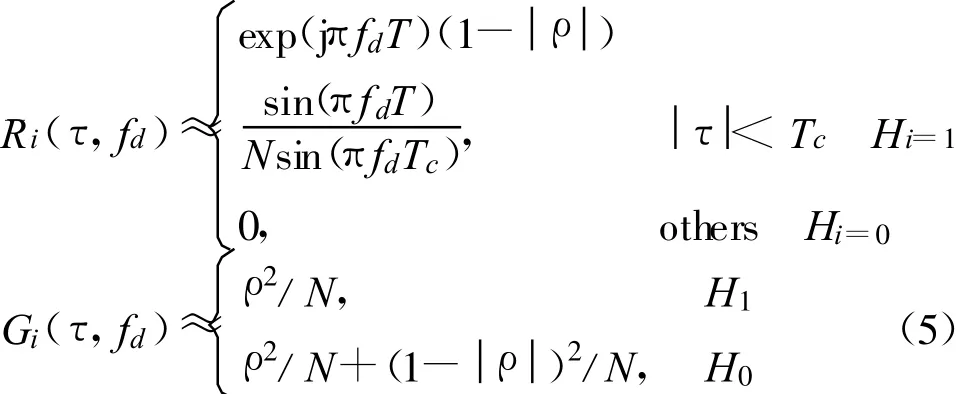
where ρ equals to Δτ/Tc-[Δτ/Tc],[·]denoting the integer portion of a number.N is the length of Pn(t)and Tcis chip duration of Pn(t).
Assuming τ=kTc+ε,0≤ε≤Tc,τ′=k′Tc,k,k′is an integer,namely the real signal and repeater jamming have integral chip delay time,fJ-fIF=fd,

So the mean value of J,which is the peak value of the correlation between repeater jamming and local signal is:

Equation(7)shows that there is always peak of correlation between repeater jamming and local signal,whose height depends on jamming power and relative delay time τ′.The more the jamming power is and the less the relative delay time is,the higher the peak is.It is because of existence of the peak that repeater jamming increases probability of false alarming remarkably,deteriorating system′s performance,but doesn′t affect probability of detection.Therefore it is doable to study effect of repeater jamming by analyzing changes of probability of false alarming.Repeater jamming is all the same as the real signal but the time delay,so peak after correlation must have jitter too,which is supposed as that of real peak in(5).Only special case when ε=0 is discussed here.
Here come the two hypotheses:


where I0(·)is zero Bessel function.
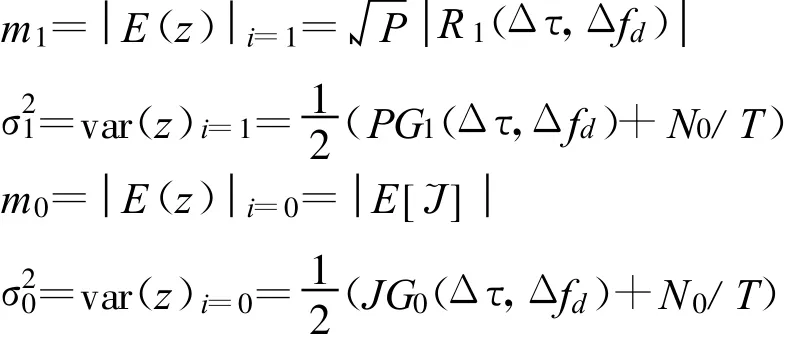
It is easy to see that the output of the complex correlator nearly obeys Rice distribution,the probability density function of decision variable x= z2is[9]:
Here are obtained the probability of detection,Pd,and false alarming,Pfa,of DS/FH signal for TT&C under repeater interference:

where Ec/N0is chip signal power to noise power density ratio,C is normalizing threshold.Considering range of normalizing threshold[10]and existence of interference,it is reasonable to set 10 as the value of C,which nearly is the value inAWGN channel when Pfais 10-3and Ec/N0is-10 dB-Hz.
3.2 PSLR and Correlation Coefficient
The effect of jamming was gainedby deteriorating the correlation performance,because its existence doesn′t only reduce the real main lobe,but increases side lobes.Repeater jamming is so alike with the real signal that they are highly correlative with each other,and there are two peaks in correlation figure,just as shown in Fig.2,in which the real one is located at nearly 150 chips.Thus the study of changes in correlation under jamming is of great importance.
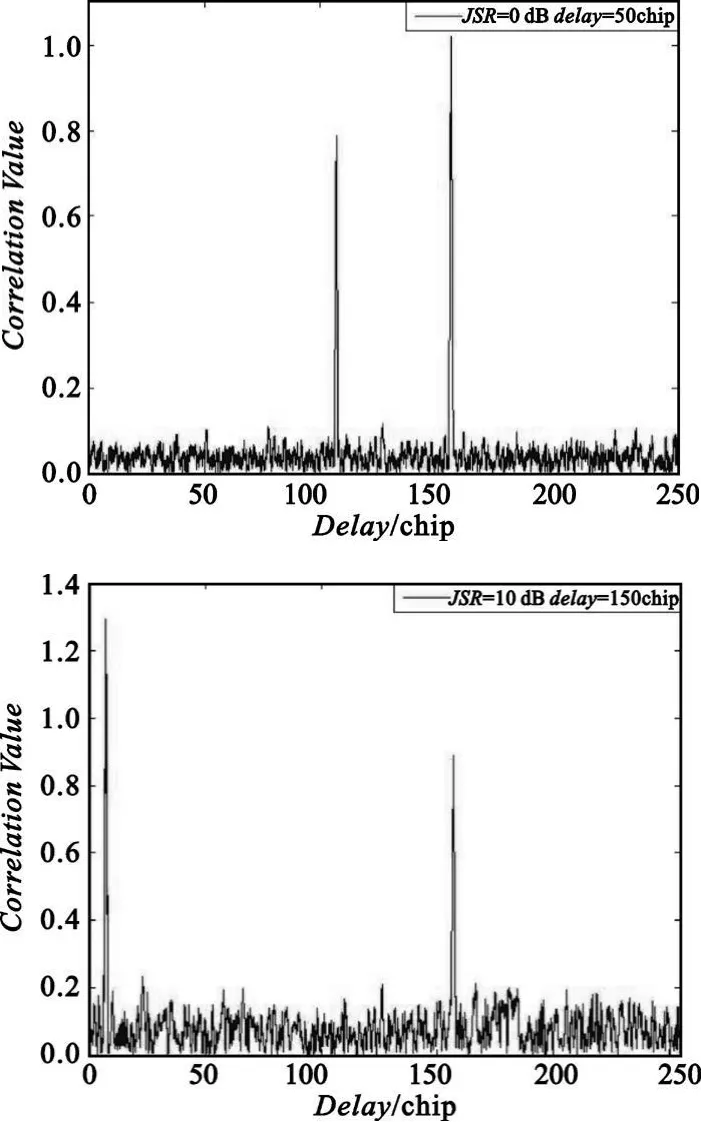
Fig.2 Correlation value under different condition图2 不同环境下的相关图
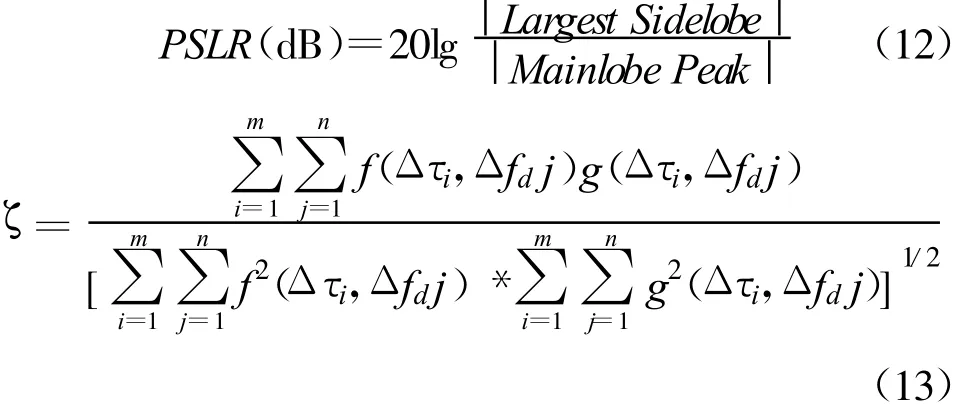
where f(Δτi,Δfdj)and g(Δτi,Δfdj)stand for Time-Doppler two-dimensional correlation figure.
PSLR stands for the peak of side lobe and main lobe ratio in correlation figure,defined in(12),which describes effect of jamming on correlation.The smaller the PSLR is,the better the performance is.PSLR equals to-20lgN in ideal situation,and approximately is-48 dB when N=255.
Usually used in study of imaging radar to evaluate effect of jamming,the Correlation Coefficient(CC)describes the correlation degree between two images which are correlation figures before and after being jammed.Similarly,correlation coefficient can be adopted here,defined in(13).The more closely the value of CC approaches 1,the less the jammed effect is.Only time dimension is considered here.
4 Simulation and Analysis
The aforementioned deduction is simulated in numerical and Mote Carlo wayshere based onMatlab/Simulink.In order to lower the sampling frequency and simulation time,the period of stochastic code,T,is set to 1 ms,moreover,the remaining Doppler frequency after coarse acquisition and T have relationship of fd*T=0.3.It surely makes no difference to conclusion under these assuming factors.Ec/N0is set to-10 dB-Hz in the following simulations.

Fig.3 Probability of false alarming versus relative time delay with different JSR图3 不同时延下的虚警概率
4.1 Probability of false alarming
As shown in Fig.3,Pfanearly equals to 0 with relative delay time τ′less than chip duration,denoting jamming doesn′t worsen system′s performance,but promotes the acquisition of real signals;Pfaincreases quickly up to 1when τ′is little more than chip duration,because repeater jamming obtains almost all the processing gain comparing real signal,which results in the highest jamming power;peak side lobe slowly decreases with τ′increasing,because FH pattern delays largely and only partial correlation exists between repeater jamming and local PN code,that iswhy Pfakeeps decreasing.When τ′in-creases to hop duration,FH pattern of repeater jamming is completely stagger with that of local signal,so repeater jamming can′t be dehoped and deteriorates to common blanking jamming,then Pfais back down nearly to 0 when JSR is not large enough.
Fig.4 shows that Pfaalways approximately equals to 0 when τ′is little,here just the special case τ′=0 is considered.Repeater jamming doesn′t deteriorate system′s performance,contrarily promotes acquisition in this situation.When τ′becomes a little larger than chip duration,Pfais increasing with JSR larger and larger.Moreover,the longer repeater jamming delays,the more power needed to increase Pfa,because partial correlation peak is smaller under the same conditions when relative delay time is larger.

Fig.4 Probability of false alarming versus JSR with different relative time delay图4 不同干信比下的虚警概率
4.2 PSLR and Correlation Coefficient
Fig.5 shows that the correlation coefficient and PSLR are almost the same value with that of no jamming situation when τ′is smaller.The larger the JSR is,the more slowly the performance get better with increasing τ′.When jamming power is little enough,PSLR is around-20 dB in Fig.5,which has much difference with theoretical value(-48 dB),because of the existence of noise.
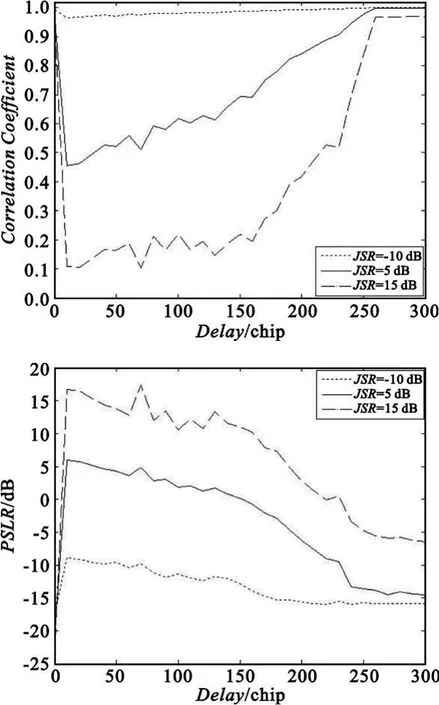
Fig.5 Correlation coefficient and PSLR versus relative time delay with different JSR图5 不同时延下的相关系数
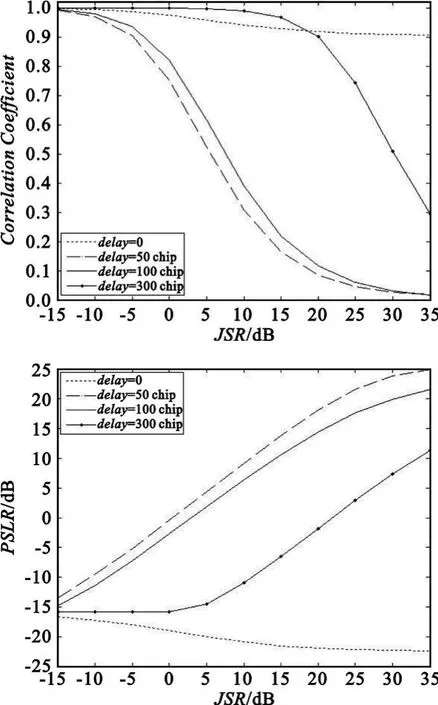
Fig.6 Correlation coefficient versus JSR with different relative time delay图6 不同干信比下的相关系数
Fig.6 shows that correlation coefficient is decreasing while PSLR is increasing with JSR becoming larger and larger when τ′is less than hop duration.Correlation co-efficient and PSLR could be worsened with large enough jamming power when τ′exceeds hop duration,because repeater jamming has deteriorated to common blanket jamming now.
5 Conclusions
This paper analyzed the performance of DS/FH signals for TT&C under repeater jamming.Existence of repeater jamming will promote acquisition of real signal when relative delay time τ′is less than chip duration.Whereas FH patterns of repeater jamming and local signals will miss a little and become partially correlative with each other when τ′is a little larger than chip duration,but as long as the jammer enhances jamming power enough,it is also possible to worsen system′sperformance,including Correlation Coefficient decreasing while Pfaand PSLR increasing quickly.If τ′is too large,FH pattern will miss so much and peak of partial correlation will become so little or even to zero that repeater jamming will deteriorate to common blanket jamming which is to be spread seriously by DS/FH system and couldn′t interfere effectively.
[1] YANG Wen-ge,MENG Sheng-yun,W ANG Jin-bao.Analysis of a Synchronization Scheme for DS/FH TT&C Signals[J].T elecommunication Engineering,2009,49(6):5-9.(in Chinese)杨文革,孟生云,王金宝.DS/FH测控信号的一种同步方案分析[J].电讯技术,2009,49(6):5-9.
[2] Lee JH,Yu B S,Lee S C.Probability of error for a hybrid DS/SFH spread-spectrum system under tone-jamming[C]//Proceedings of 1990 IEEE Military Communication Conference.Monterey,CA:IEEE,1990:410-414.
[3] Laxpati M A,Gluck J W.Optimization of a Hybrid SFH/DS MFSK with Nonoverlapping FH Slots in the Presence of Worst Case Multitone Jamming[J].IEEE Transactions on Communications,1995,43(6):2118-2125.
[4] Schleher D C.Electronic Warfare inthe Information Age[M].New York:Artech House,Inc,1999:288-289.
[5] Wang Hang,Guo Jingbo,Wang Zanji.Feasibility Assessment of Reapter Jamming Technique for DSSS[C]//Proceedings of 2007 Wireless Communications and Networking Conference.Kowloon:IEEE,2007:2322-2327.
[6] CAO Yan-xia,TIAN Bin.Study of a Novel Retransmitted Jamming of GPS Receivers[J].IT Age,2006(4):67-70.(in Chinese)曹艳霞,田斌.GPS转发干扰模式的研究[J].电子科技,2006(4):67-70.
[7] ZHOU Wen-jiong,XIAO Xiang-yu,ZHU Li-dong,et al.Delay Analysis and Sumulation of Repeating Deception Jamming Based on Micro-Satellite System[J].Electronic Information Warfare Technology,2006,21(6):27-30.(in Chinese)周文炯,肖翔宇,朱立东,等.微小卫星转发式欺骗干扰的时延分析和仿真[J].电子信息对抗技术,2006,21(6):27-30.
[8] TENG Zhen-yu,FENG Yong-xin,PAN Cheng-sheng.Analysis on the Effect of Part Time-resident In terference on FH/DS Communication System Synchronization[J].Information and Control,2008,37(5):627-632.(in Chinese)腾振宇,冯永新,潘成胜.部分驻留时间干扰对FH/DS通信系统同步影响分析[J].信息与控制,2008,37(5):627-632.
[9] Polydoros A,Weber C L.A unified approach to serial search spread spectrum code acquisition-Part 11[J].IEEE Transactions on Communications,1984,32(5):550-559.
[10] Yang Wenge,Meng Shengyun,Wang Jinbao,et al.Acquisition Performance Analysis of a Synchronization Scheme of DS/FH Hybrid Spread Spectrum Signals for TT&C[C]//Proceedings of 9th International Conference on Electronic Measurement&Instruments.Beijing:IEEE,2009:395-399.
